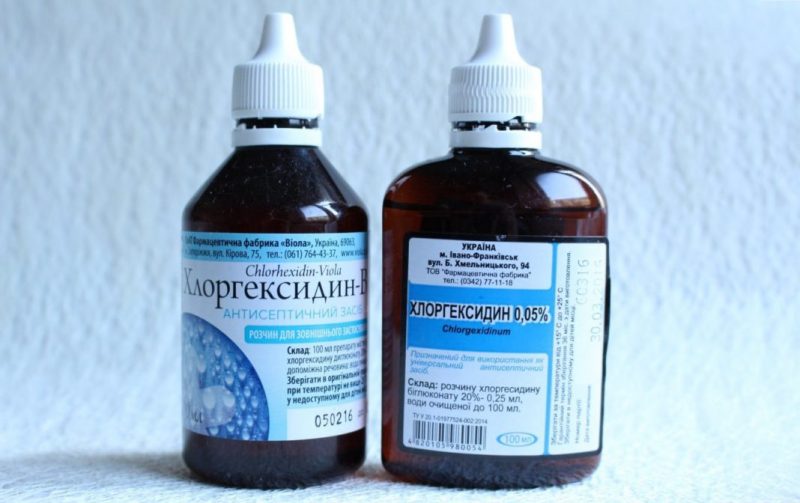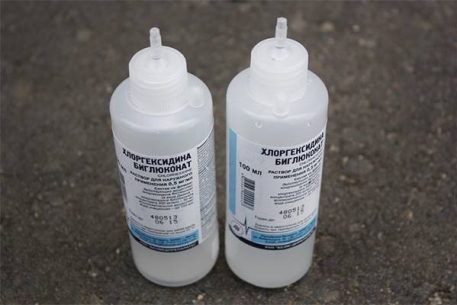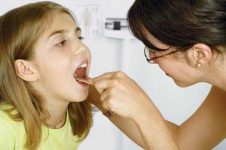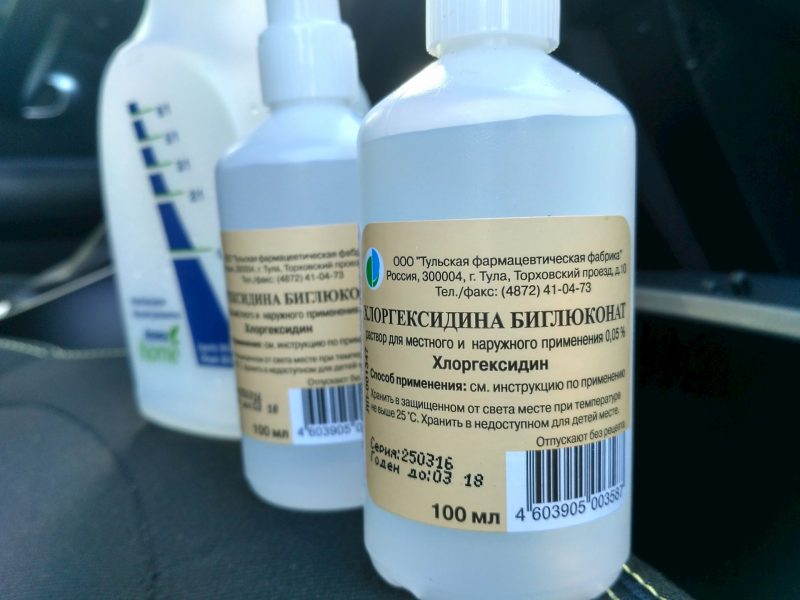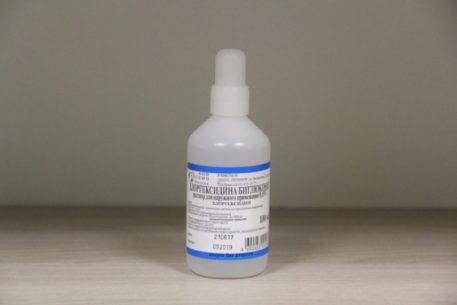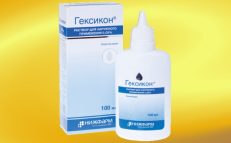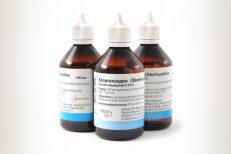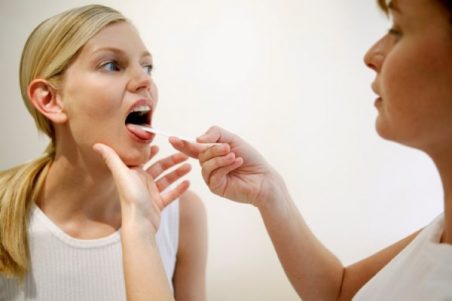Rinsing is an effective treatment for many diseases of the oral cavity and throat. Many are interested in how to gargle with chlorhexidine.
Material Content:
The composition of the drug
Chlorhexidine is an antiseptic that is very active against various bacteria: streptococci, staphylococci, chlamydia, E. coli, and tuberculosis pathogens. Outwardly, it is an unremarkable transparent liquid and resembles ordinary water. The taste is bitter, therefore it is difficult to force children to use this method of treatment.
The main active ingredient is chlorhexidine bigluconate. The concentration of the solution is different. A 5 percent solution is used to treat the hands of medical staff, the surgical field and instruments, to disinfect the hands of workers in food enterprises, to cleanse the injection site in laboratories. For the treatment of various diseases using a weak solution of 0.05 or 0.1%.
In which cases is prescribed chlorhexidine
Gargling with chlorhexidine is indicated in such cases:
- tonsillitis;
- pharyngitis, laryngitis, tracheitis;
- flu;
- ARVI, ARI;
- all forms of tonsillitis.
As a rule, the drug is prescribed in combination with other drugs, which only a doctor is entitled to prescribe.
The drug should be used only topically.It is necessary to rinse the throat with chlorhexidine with angina correctly, only then this procedure will give the expected effect: it will ease pain, prevent the spread of a pathogenic infection. The medicine gently envelops the inflamed area, forming a special film, and does its healing work.
Instructions for use for adults and children
For therapeutic use, a solution of 0.05% is used. It is already ready for use and it is not necessary to breed it further. In cases of urgent need, you can use a more concentrated solution, after diluting it to the desired concentration.
How to dilute the solution
Dilute chlorhexidine for rinsing with boiled or distilled water. For ease of dosing, it is better to use a large medical syringe. If the medicine is prepared at once, you can use a pipette. One drop is 0.04 ml.
To get 200 ml of a solution of 0.01%, you need to mix 0.4 ml of a 5 percent solution and 199.6 ml of distilled water.
When using the solution, you need to monitor the dosage and avoid ingestion, as this can cause harm.
Rinse procedure
Immediately before the procedure, you need to rinse your mouth and throat well with warm water to remove food debris, dirt and excess microbes from the surface of the mucous membranes. Then, a small amount of solution (about 1 tablespoon) is taken in the mouth and rinsed for no more than 35 seconds. Long interaction with the mucous membranes is also harmful. It is impossible to swallow liquid, it needs to be spit out. After the procedure, do not drink or rinse your mouth with water to eliminate the unpleasant aftertaste. It takes a little patience for the medicine to give a full effect.
It is best to gargle twice a day - after breakfast and after dinner. Treatment continues until the patient's condition improves.
If the sore throat is very strong, the number of procedures can be increased to 3-4, but only after consultation with the doctor. Excessive enthusiasm for the drug can cause side effects: dry mouth, taste disturbances, darkening of enamel.
Read also:dry mouth - what causes the disease
After rinsing, do not eat and brush your teeth for 1-2 hours. If before the procedure, for example, at night the patient wants to brush his teeth, he should rinse his mouth thoroughly. The ingredients contained in toothpaste can significantly reduce the effectiveness of the drug.
An ENT can recommend rinsing a child if he is already 7 years old (although the instructions for the drug indicate that use is permitted from the age of 12). But it often happens that a schoolboy still doesn’t know how to gargle himself, then he’d better just irrigate it with the help of an adult.
Sequencing:
- tilt the child over the sink face down;
- inject the solution with a special syringe on the affected area so that it again flows into the sink.
The maximum irrigation time is 30 seconds. Children are better off using a weaker solution, half diluting it with warm water.
During pregnancy and lactation
Women who are expecting a baby and nursing mothers should not use this medication without the need. Gargling with chlorhexidine during pregnancy is possible only in exceptional cases, when the benefit exceeds the possible harm, and the medicine is recommended by the doctor himself.
The tool helps to accelerate recovery in severe forms of tonsillitis and improve the condition of a pregnant woman. In some cases, for safety reasons, doctors recommend that you do not gargle, but simply wipe the inflamed sections of the larynx.
Drug interaction
In general, the drug normally interacts with other substances. But it is not worth using it simultaneously with iodine and alkaline solutions, as this reduces the effectiveness of chlorhexidine and can be harmful.
Ethyl alcohol favorably affects the effectiveness of the drug, so alcohol solutions are well-deserved.
Precautions and contraindications
If the patient feels a burning sensation during the procedure, this indicates that the solution was not prepared correctly: its concentration is too high. In this case, immediately rinse your mouth thoroughly with water. Sometimes the patient can make a mistake and take a medicine with a high concentration to prepare the solution. The maximum allowable concentration is 0.5%.
The use of undiluted concentrated solution can provoke a burn of the mucous membrane or a severe allergic reaction.
Do not swallow the medicine. If a few drops of liquid get inside, nothing bad will happen, but you should not do this on purpose. For this reason, this solution is not recommended for rinsing young children who can accidentally swallow a considerable amount of medicinal fluid. Getting a large amount of solution inside is dangerous. In this case, you need to rinse the stomach, take sorbents and report the incident to the doctor.
Of the contraindications to be mentioned:
- individual intolerance;
- childhood;
- recent eye or ear surgery
In the absence of contraindications, treatment is successful.
The shelf life of the drug is 24 months, provided that it is stored in a dark place at a temperature of no higher than +24 degrees.
Similar in composition
Of the analogues, one can mention the following solutions:
- Hexicon. It is often used to eliminate dental problems - gingivitis, stomatitis, periodontitis.
- Amident. The list of indications includes tonsillitis, as well as postoperative patient care in the otolaryngological and dental departments.
Chlorhexidine is one of the most popular drugs in its group. It is effective, and its cost is much lower than similar tools.


